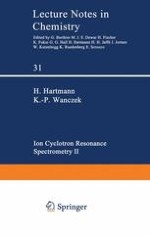1982 | OriginalPaper | Buchkapitel
FT ICR Spectrometry with a Superconducting Magnet
verfasst von : M. Allemann, Hp. Kellerhals, K. P. Wanczek
Erschienen in: Ion Cyclotron Resonance Spectrometry II
Verlag: Springer Berlin Heidelberg
Enthalten in: Professional Book Archive
Aktivieren Sie unsere intelligente Suche, um passende Fachinhalte oder Patente zu finden.
Wählen Sie Textabschnitte aus um mit Künstlicher Intelligenz passenden Patente zu finden. powered by
Markieren Sie Textabschnitte, um KI-gestützt weitere passende Inhalte zu finden. powered by
Since ICR spectrometry [1] was introduced in 1965 [2] great progress has been made in instrumentation. Among the most important new methods were: 1. Introduction of pulsed spectrometry with a trapped — ion analyzer cell [3] and 2. Fourier transform ICR spectrometry [4]. The early instruments utilized a magnetic field scan to obtain a mass spectrum. This has several disadvantages: The scan is slow, trapping efficiency and sensitivity are changing with magnetic field strength. The strength of the magnetic field is not well defined and its homogeneity is not high. Therefore a frequency scan at constant magnetic field is preferable. Once operating at constant magnetic field the use of superconducting high field magnets yields substantial improvements: 1.Very high resolution,2.Large mass range3.Very long trapping times4.Capability of simple mass scale calibration stable for extended periods of time utilizing the great field stability of the superconducting magnet.
